Etsy Bundle
How Did Etsy Go From a Brooklyn Startup to a $12.5 Billion Marketplace?
Etsy's story began in 2005 in Brooklyn, New York, with a simple mission: to give artisans a platform. Founded by Robert Kalin, Chris Maguire, and Haim Schoppik, Etsy aimed to 'keep commerce human' by connecting unique creators with buyers. This vision transformed into a thriving Etsy SWOT Analysis, becoming a significant player in the e-commerce landscape.
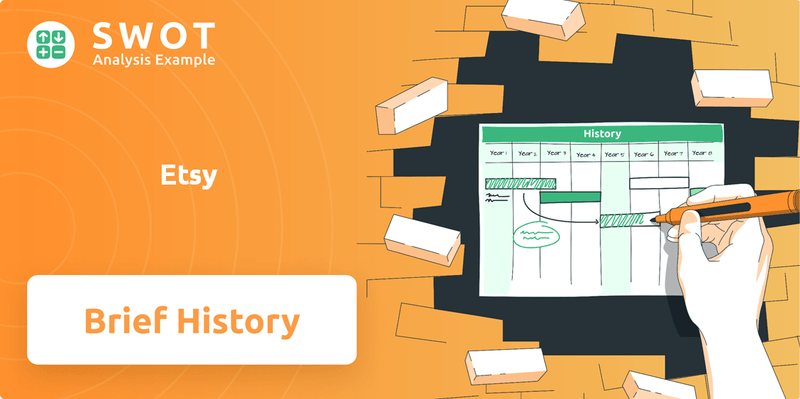
From its humble beginnings, the Etsy company has experienced remarkable Etsy growth, evolving from a digital craft fair to a global marketplace. The Etsy marketplace has seen significant expansion, with its revenue reaching billions and a massive user base. This article will delve into the brief history of Etsy, exploring its key milestones and the challenges faced during its journey to success.
What is the Etsy Founding Story?
The story of the Etsy company began on June 18, 2005. It was brought to life by Robert Kalin, Chris Maguire, and Haim Schoppik, with Jared Tarbell later joining the team. This marked the start of what would become a significant player in the online marketplace for handmade and vintage goods.
The concept for Etsy stemmed from Kalin's personal experience. He found it challenging to sell his handcrafted wooden computer. This experience highlighted the need for an online platform where artisans could directly connect with consumers. The founders, all based in Brooklyn, New York, envisioned a space specifically for crafters, vintage collectors, and artisans, setting themselves apart from larger marketplaces.
The early days of Etsy involved sellers creating their own storefronts on the website. They listed their items for a fee of US$0.20 per item. The name 'Etsy' was chosen by Kalin, who was looking for a unique word. He found inspiration in the Italian phrase 'etsi' (meaning 'oh, yes') while watching Federico Fellini's movie '8½'. Early financial backing came from Union Square Ventures and founders of Flickr and Delicious. The initial site was developed in just two and a half months.
The Etsy marketplace quickly gained traction, focusing on a niche market of handmade and vintage items. This strategy helped it to differentiate itself from competitors. The initial business model was straightforward, allowing sellers to easily set up shops and list their products.
- The platform's focus on unique, handcrafted items attracted both sellers and buyers.
- Early funding from investors like Union Square Ventures helped fuel the company's growth.
- The founders' tech-savvy backgrounds were crucial in developing the platform quickly.
- The initial fee structure was designed to be accessible for small businesses and individual sellers.
Etsy SWOT Analysis
- Complete SWOT Breakdown
- Fully Customizable
- Editable in Excel & Word
- Professional Formatting
- Investor-Ready Format
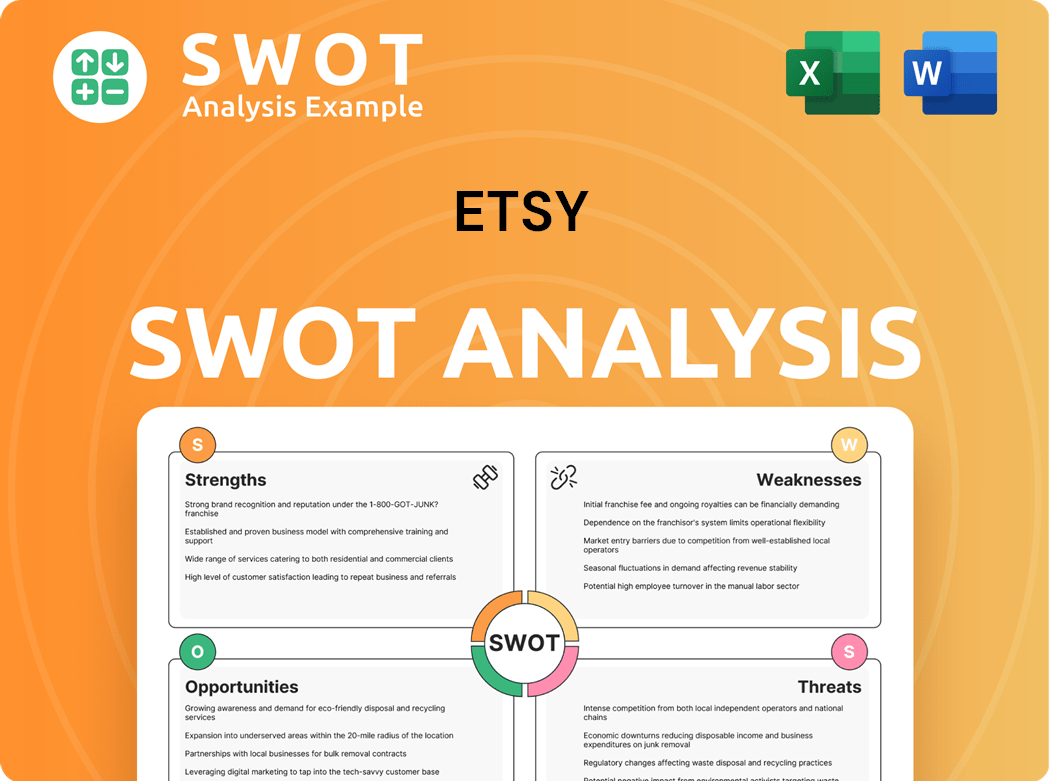
What Drove the Early Growth of Etsy?
The Etsy company focused on driving traffic early on by frequently introducing new tools to help sellers gain visibility. This strategy proved effective, leading to rapid expansion and significant sales milestones. Despite its early success, the company was not yet profitable by the end of 2007, setting the stage for further investment and strategic shifts.
By May 2007, Etsy had surpassed $1.7 million in sales, and by July 2007, it celebrated its one-millionth sale. In November 2007, buyers spent $4.3 million on 300,000 items, a 43% increase from the previous month. These figures highlight the early Etsy growth and its increasing popularity among both buyers and sellers.
In January 2008, the Etsy secured an additional $27 million in funding. Key leadership transitions also occurred, with Maria Thomas becoming CEO in 2008. Chad Dickerson, who joined as CTO in September 2008, was instrumental in building out Etsy's engineering team, a crucial turning point for the company.
Etsy made its first acquisition in 2009, purchasing Adtuitive. By 2012, Etsy had raised $40 million in Series F funding and expanded into international markets. This expansion included France, Germany, and Australia, indicating a broader global strategy for the Etsy marketplace.
In 2024, Etsy's core geographic markets include the US, UK, Canada, Australia, France, and Germany. The company's gross merchandise sales (GMS) peaked in 2021 at $13.5 billion, though it saw a correction to $12.5 billion in 2024. Etsy's revenue reached $2.8 billion in 2024, with a slight 2.1% year-over-year increase. For further insights into Etsy's strategies, consider reading about the Growth Strategy of Etsy.
Etsy PESTLE Analysis
- Covers All 6 PESTLE Categories
- No Research Needed – Save Hours of Work
- Built by Experts, Trusted by Consultants
- Instant Download, Ready to Use
- 100% Editable, Fully Customizable
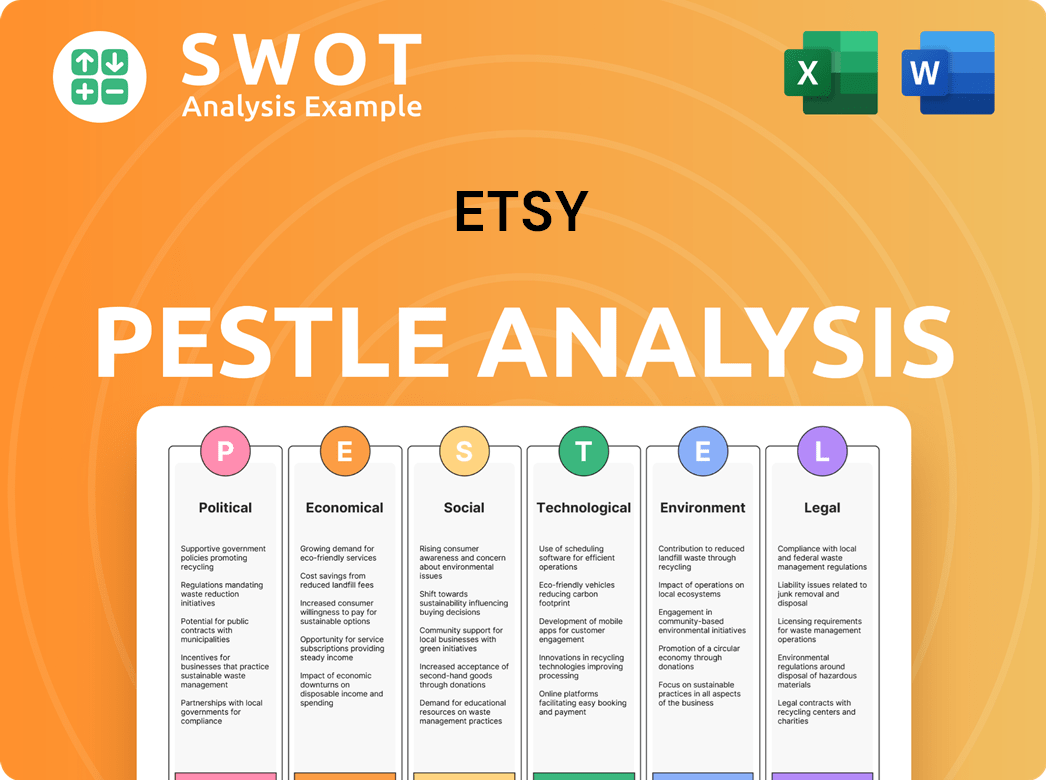
What are the key Milestones in Etsy history?
The Etsy company has a fascinating Etsy history, marked by significant achievements and changes since its inception. From its early days to its current status as a major e-commerce platform, Etsy's journey reflects its adaptability and commitment to its community. Understanding the Etsy origin story and its evolution provides valuable insights into its current operations and future prospects.
| Year | Milestone |
|---|---|
| 2005 | Etsy was founded, providing a marketplace for handmade and vintage goods. |
| 2013 | The platform began allowing mass-manufactured items, expanding its product offerings. |
| 2015 | Etsy went public with an IPO, valuing the company at $1.8 billion. |
| 2023 | Launched the 'Make an Offer' feature, enhancing buyer-seller interactions. |
Etsy has consistently innovated to improve the user experience on its Etsy marketplace. This includes a strong emphasis on its mobile app, which has a higher conversion rate, and the introduction of features like 'Gift Mode' to facilitate gifting.
Etsy has invested heavily in its mobile app, recognizing its importance for sales. The app's higher conversion rate underscores its significance in the Etsy growth strategy.
The 'Gift Mode' feature provides an interactive gifting hub, enhancing the platform's appeal. This innovation makes Etsy a more user-friendly option for gift-givers.
The 'Make an Offer' feature, introduced in 2023, allows buyers to negotiate prices with sellers. This feature enhances the interaction between buyers and sellers.
Despite its successes, Etsy faces several challenges. The company has experienced a decline in Gross Merchandise Sales (GMS), with consolidated GMS down 6.8% in Q4 2024. Furthermore, the platform has seen a decrease in active buyers and sellers, and has dealt with issues such as rising transaction fees and concerns about counterfeit items, as discussed in the article Owners & Shareholders of Etsy.
Etsy experienced a decline in Gross Merchandise Sales (GMS) in Q4 2024, reaching $3.7 billion, a 6.8% decrease compared to the previous year. Full-year 2024 GMS was $12.5 billion, a 4.5% decline from 2023.
The number of active buyers on the Etsy marketplace decreased by 2.6% to 89.6 million in 2024. Active sellers also saw a significant drop, declining by 20% to 5.6 million.
Etsy has faced criticism regarding increased transaction fees, which rose from 5% to 6.5% in 2022. Concerns about counterfeits and mass-produced items have also been a challenge.
In response to market pressures, Etsy implemented workforce reductions, laying off 11%, or 225 employees, in December 2023. This was part of a broader effort to streamline operations.
Etsy Business Model Canvas
- Complete 9-Block Business Model Canvas
- Effortlessly Communicate Your Business Strategy
- Investor-Ready BMC Format
- 100% Editable and Customizable
- Clear and Structured Layout
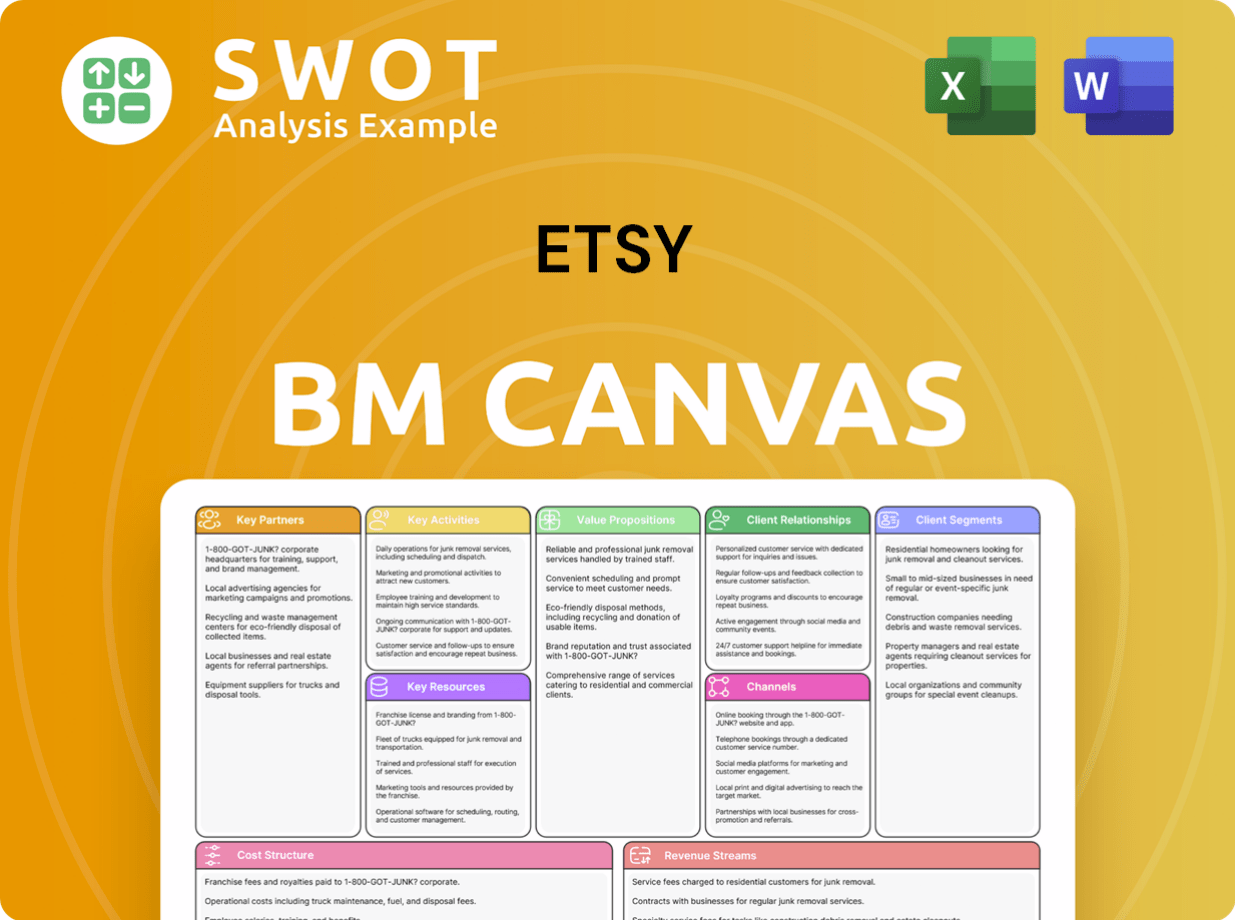
What is the Timeline of Key Events for Etsy?
The Etsy company has a rich history, evolving from its humble beginnings to a global marketplace. Founded by Robert Kalin, Chris Maguire, and Haim Schoppik, Etsy launched on June 18, 2005. The Etsy marketplace quickly gained traction, reaching its one-millionth sale by July 2007. Over the years, Etsy has experienced significant growth, navigated funding rounds, and adapted to market changes, including a period of substantial expansion during the COVID-19 pandemic. The company's journey includes key acquisitions, strategic leadership changes, and adjustments to its business model, such as increases in seller transaction fees. Recently, Etsy has focused on refining its platform, addressing seller concerns, and leveraging technology to enhance both buyer and seller experiences. To learn more about the company's core values, read this article about Mission, Vision & Core Values of Etsy.
| Year | Key Event |
|---|---|
| June 18, 2005 | Etsy is officially launched by Robert Kalin, Chris Maguire, and Haim Schoppik. |
| July 2007 | Etsy records its one-millionth sale. |
| January 2008 | Etsy receives $27 million in additional funding. |
| August 2008 | Chris Maguire and Haim Schoppik leave the company. |
| September 2008 | Chad Dickerson joins as Chief Technology Officer. |
| 2009 | Etsy acquires its first company, Adtuitive. |
| July 2011 | Chad Dickerson replaces Rob Kalin as CEO. |
| 2012 | Etsy raises $40 million in Series F funding and expands internationally. |
| 2013 | Etsy begins allowing sellers to sell mass-manufactured items. |
| 2015 | Etsy completes its Initial Public Offering (IPO). |
| 2020-2021 | Experiences significant growth during the COVID-19 pandemic, with GMS peaking at $13.5 billion in 2021. |
| 2021 | Acquires Depop for $1.6 billion and Elo7 for $217 million. |
| 2022 | Increases seller transaction fees from 5% to 6.5%, leading to seller protests. |
| December 2023 | Lays off 11% of its workforce (225 employees) due to stalled growth. |
| 2024 | Etsy's revenue reaches $2.808 billion, with 95.5 million active buyers and 8.1 million sellers. |
| Q1 2025 | Reports consolidated revenue of $651.2 million, up 0.8% year-over-year, despite a 6.5% decline in consolidated GMS to $2.8 billion. |
Etsy is focusing on technological improvements. This includes leveraging AI and machine learning. The goal is to streamline seller operations. The improvements also enhance discoverability on the mobile app.
The company is returning to its core mission. This involves keeping commerce human. It also includes cleaning up the marketplace. The company aims to remove listings that violate its handmade policy.
Etsy plans to increase buyer engagement. It aims to drive more sales. The company anticipates a return to GMS growth. This is expected in the second half of 2025.
The company intends to expand internationally. Etsy also plans to diversify product categories. The goal is to double its market size. The company aims to empower creative entrepreneurs.
Etsy Porter's Five Forces Analysis
- Covers All 5 Competitive Forces in Detail
- Structured for Consultants, Students, and Founders
- 100% Editable in Microsoft Word & Excel
- Instant Digital Download – Use Immediately
- Compatible with Mac & PC – Fully Unlocked
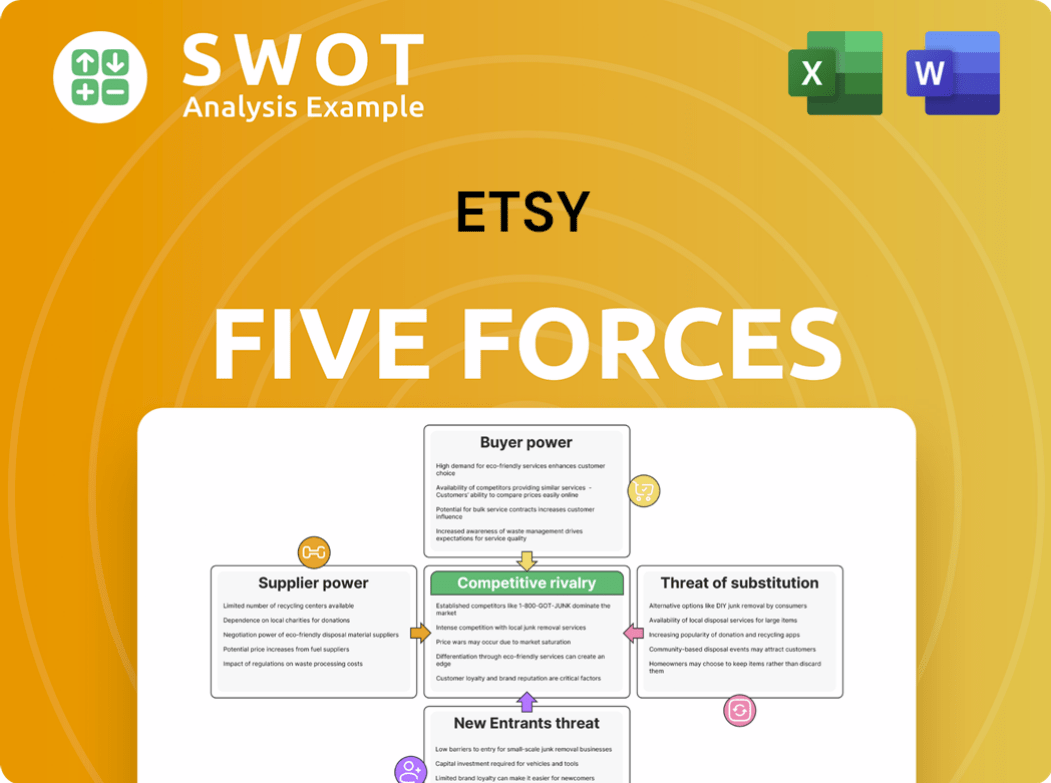
Related Blogs
- What is Competitive Landscape of Etsy Company?
- What is Growth Strategy and Future Prospects of Etsy Company?
- How Does Etsy Company Work?
- What is Sales and Marketing Strategy of Etsy Company?
- What is Brief History of Etsy Company?
- Who Owns Etsy Company?
- What is Customer Demographics and Target Market of Etsy Company?
Disclaimer
All information, articles, and product details provided on this website are for general informational and educational purposes only. We do not claim any ownership over, nor do we intend to infringe upon, any trademarks, copyrights, logos, brand names, or other intellectual property mentioned or depicted on this site. Such intellectual property remains the property of its respective owners, and any references here are made solely for identification or informational purposes, without implying any affiliation, endorsement, or partnership.
We make no representations or warranties, express or implied, regarding the accuracy, completeness, or suitability of any content or products presented. Nothing on this website should be construed as legal, tax, investment, financial, medical, or other professional advice. In addition, no part of this site—including articles or product references—constitutes a solicitation, recommendation, endorsement, advertisement, or offer to buy or sell any securities, franchises, or other financial instruments, particularly in jurisdictions where such activity would be unlawful.
All content is of a general nature and may not address the specific circumstances of any individual or entity. It is not a substitute for professional advice or services. Any actions you take based on the information provided here are strictly at your own risk. You accept full responsibility for any decisions or outcomes arising from your use of this website and agree to release us from any liability in connection with your use of, or reliance upon, the content or products found herein.